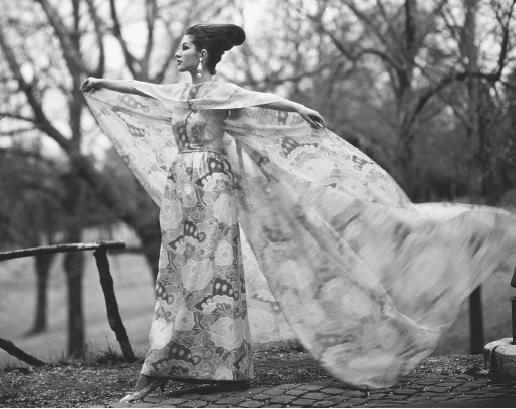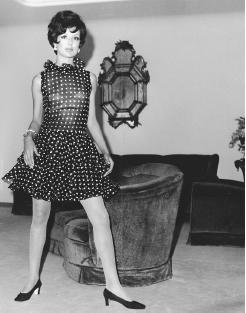Irene Galitzine - Fashion Designer Encyclopedia
Russian designer working in Rome
Born: Tiflis, Russia, 1916. Education: Studied art and design in Rome. Family: Married Silvio Medici. Career: Assistant, Fontana, circa 1945-48; established own import business, Rome, 1949; first collection, 1959; business closed 1968; worked as freelance designer, 1968-70; designer for own business, reopened as Princess Galitzine, from 1970. Awards: Filene award for new talent, Boston, 1959; Designer of the Year award, Italy, 1962; Sunday Times International Fashion award, 1965; Isabella d'Este award, Italy, 1965.
Publications
On GALITZINE:
Books
Lambert, Eleanor, World of Fashion: People, Places, Resources, New York & London, 1976.
Soli, Pia, Il genio antipatico (exhibition catalogue), Venice, 1984.
Villa, Nora, Le regine della moda, Milan, 1985.
Stegemeyer, Anne, Who's Who in Fashion, Third Edition, New York,1996.

Articles
"Galitzine seta e lustrine: tutto scivola," in Vogue (Milan), September 1984.
"Roma Alta Moda: Irene Galitzine," in Vogue (Milan), September 1985.
Colen, Bruce, and Massimo Listri, "Princess Irene Galitzine: Rich Patterns in the Heart of Rome," in Architectural Digest (Los Angeles), September 1988.
***
Nathaniel Hawthorne and Henry James were Americans who dreamed of Italy; after World War II, the dream was a film, Three Coins in a Fountain, eventually superseded by the Italian-made La Dolce Vita. Italian freedom and innate style held romance; Italian nobility in the fashion and beauty industries such as Emilio Pucci, Princess Marcella Borghese, and Princess Irene Galitzine were fairytale heroes.
In the 1950s and 1960s (launching her business in 1949), Princess Irene Galitzine exemplified Roman high style and the princely life. Diana Vreeland, then of Harper's Bazaar, dubbed Galitzine's full, liquid trousers for at-home leisure (introduced to a standing ovation at the Palazzo Pitti fashion showing in 1960) "palazzo pajamas" and every aura of Renaissance and romantic (and erotic) Italy flooded the American imagination. Galitzine's palazzo pajamas were, in fact, not wholly an invention, but they became in Galitzine's countless versions of uncompromising luxury a silken reverie.
The silks of Italy were a factor, but Galitzine was especially inventive in the elaboration of the palazzo pajamas, bringing to the leisure trousers expressions of alta moda embellishment. She treated the drapey silks as a scrim for attached necklaces in the manner of Mainbocher and created other illusions of encrusted ornament and articulated hems and sleeves with beads in a manner reminiscent of Fortuny's Murano bead edges, but even more of Renaissance paintings. Even with the comfort and casualness of palazzo pajamas, the

Galitzine used applied effects not only to establish the grandeur of what might otherwise lapse into a too casual mode, but also to apply a countervailing weight to the almost fly-away big cutting of her styles. Weight and the illusion of weight was an effective punctuation of the clothing. Likewise, in her signature toga top over trousers, the elaborate fibula at the shoulder not only secures, but gives a solid balance to the loose drape.
Roman grandeur led rather dramatically, in the 1960s, to the Cardin-like futurism in Galitzine's work. A quilted vinyl jumpsuit with matching helmet on the cover of the May 1966 Harper's Bazaar is of Brave New World anticipation, but continues to observe Galitzine's dress rationalism. In the same era, she was converting her palazzo pajamas into ensembles with Empire-waisted tops and boxy jackets in reinforcement of the new geometry. In fact, her clothing had always understood lifestyle and the reductivism of the 1960s. After a brief hiatus in the late 1960s, Galitzine reopened to show for spring/summer 1970. In this collection, she used bold graphics for trousers and dresses to be worn with sleeveless tunics, again a device that could seem to step out of a Renaissance painting or step forward into fantasies of outer space.
For a fashion designer able to trace her Russian ancestry back to Catherine the Great and insistent on her Russian style even as much as her Roman, Galitzine became the epitome of Roman style. "I've always tried to design new outlines that feel good on the body…. I don't care for clothes that you have to think about after you've put them on. No elegant woman ever looks ill at ease." Galitzine's formula for easy and comfortable dressing managed to combine the avowed comfort of the clothing with an unmistakable pomp of Roman refinement and the abiding presence of Italian Renaissance luster.
Always adding to the aura of Galitzine's design was her remarkable client list, the best of Italy and an international clientéle who discovered Italian clothing in the 1950s and 1960s. Architectural Digest, in a September 1988 article, remembered Eleanor Lambert remarking of a Galitzine show, "The audience is snob, not mob." Yet, the supreme evidence is Galitzine's clothing: luxurious, inventive, high-style casualness with grace.
—RichardMartin
Comment about this article, ask questions, or add new information about this topic: